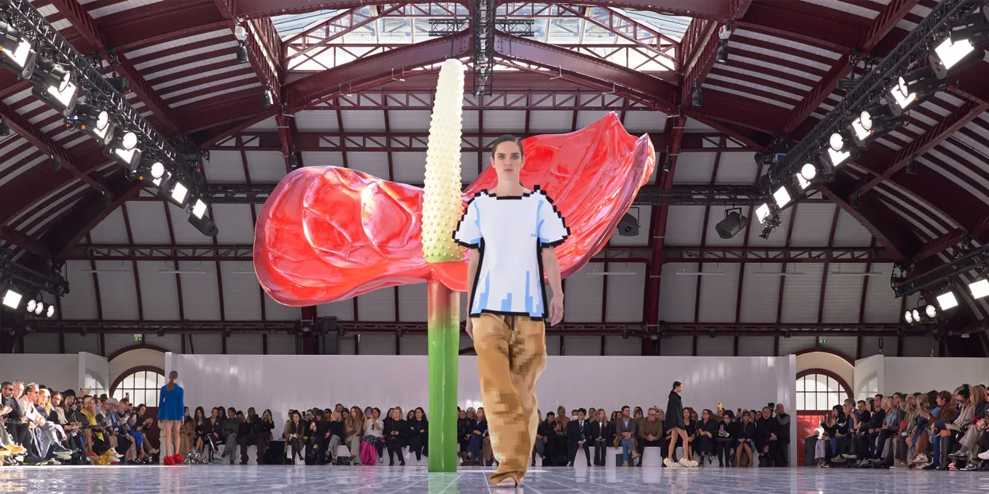In one of the most striking shows from Paris Fashion Week, plants and pixels combine in a disquieting take on tomorrow.
Fashion houses—skilled as they are at picking up on trends—have been quick to embrace the metaverse. Over the last few years, Louis Vuitton, Gucci, Balenciaga, and others, have created virtual outfits that are only available in video games. In most cases, these efforts have been gimmicks, rather than thoughtful explorations of our digital future.
But then came Jonathan Anderson, creative director of the Spanish luxury fashion house Loewe. His stunning Paris Fashion Week show—one of my favorites this season—made it clear that he isn’t interested in designing in pixels. He chose, instead, to create real garments that only look fake, warped, and pixelated. In doing so, he provoked us to reckon with what it really means for humans to abandon the real world as we migrate to digital spaces—and the disconcerting hybrid truth and illusion to ensue.
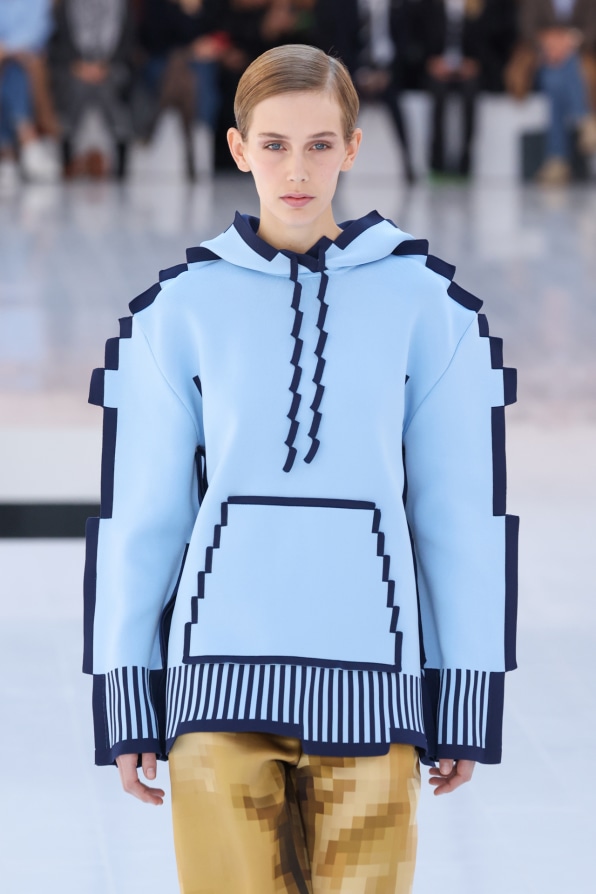
The show was a particularly bright moment in 37-year-old Anderson’s still-young career. But even in the dark days of COVID-19, when fashion weeks were canceled, Anderson found ways to channel his creativity into headline-grabbing art that was particularly appropriate for lockdown. In 2020, he created a “fashion show in a box,” sending the fashion press paper dolls that they could dress with outfits from his collection. In 2021, he created downloadable knitwear patterns so people could sew their own sweaters with their newfound pandemic crafting skills.
While Anderson was focused on these quaint, domestic projects, other luxury brands were making forays into the metaverse to capitalize on the massive spike in gaming around the world. Gucci created a town in Roblox where users could buy clothes for avatars. Balenciaga built Fortnite skins. Prada constructed outfits for the game Riders Republic.
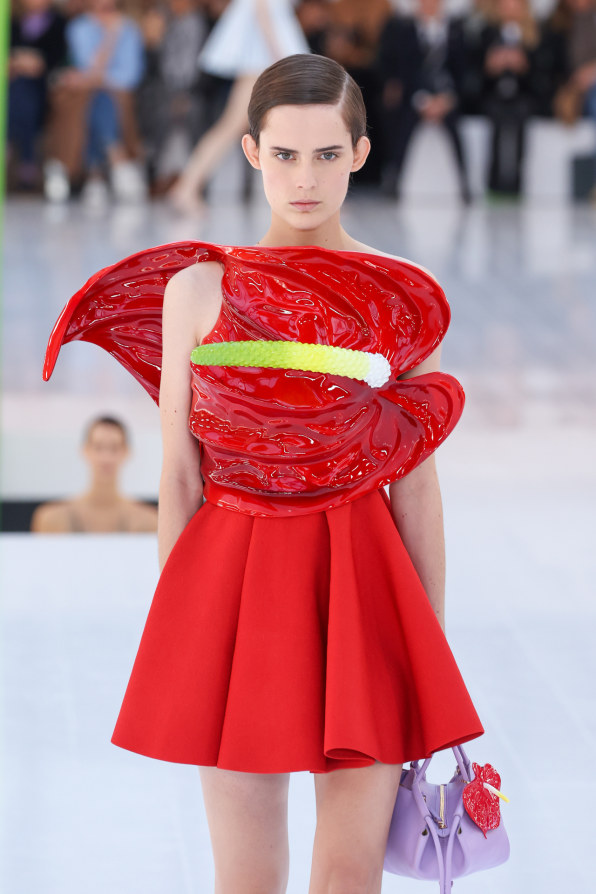
With this new show, Anderson seemed to be critiquing his peers’ impulse to jump into the digital world with such abandon. On the surface, the collection seemed optimistic—with a red flower as the main motif—but it had a dystopian undertone.
For one thing, the show took place in a stark white box with a 10-foot-tall anthurium emerging from the floor, its wide petals taking up most of the stage. The proportions were skewed in a way that so often happens in virtual worlds. Next to the enormous flower on the stage, the models looked puny. They wore tops shaped like anthuriums, with bits of their shoulders exposed, as if the flower hadn’t been completely filled out. A-line dresses were a little too short. Sweater dresses and jackets had arms that came down to the ankle. I had a visceral desire to go into the graphic design software to lengthen and shorten these garments with the click of a mouse. But of course, these were real models, wearing real garments.
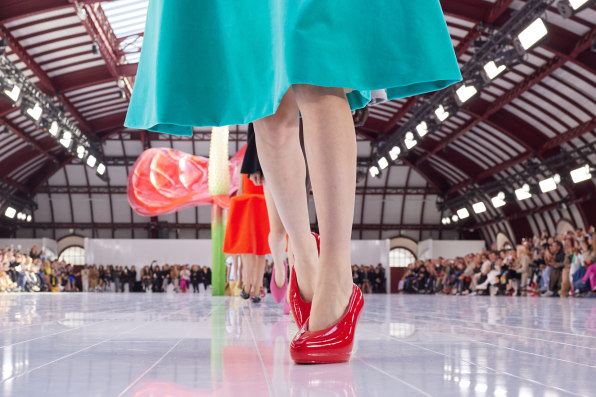
The outfits that made the biggest splash were the ones that looked pixelated—as if they were Minecraft characters come to life. A model walked across the stage in a knit hoodie and khaki trousers that were covered in little squares, which looked blurry when she moved. Another wore a white T-shirt with black edges that looked like lo-fi graphics. It was a brilliant twist. While many of Anderson’s counterparts are eager to create digital clothes that look realistic, he painstakingly crafted physical garments that look unreal in the very specific way that occurs on the internet.
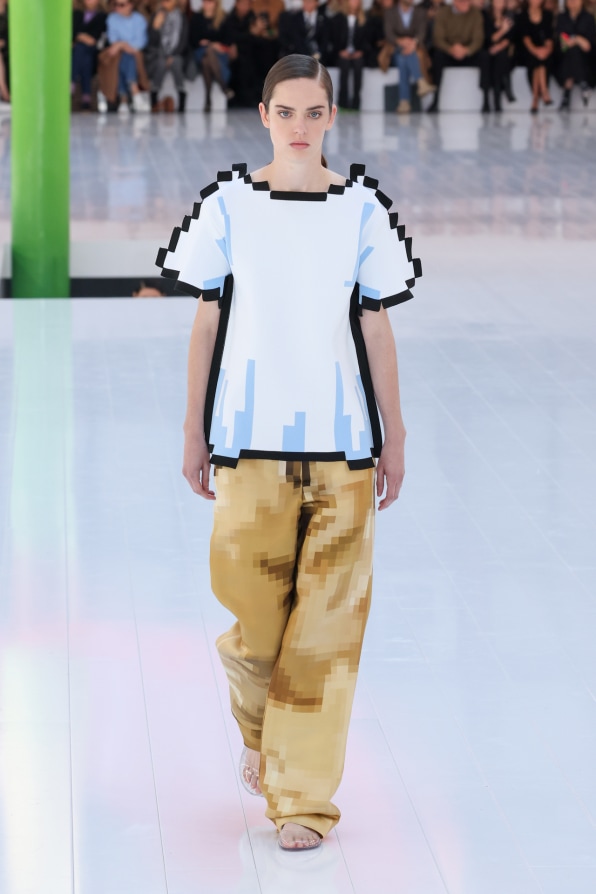
And what was the point of it all? For Anderson, creating a collection isn’t necessarily about designing garments that customers want to purchase—although these pixelated knits looked cozy and wearable. “Sometimes fashion is not about selling,” he told Cathy Horyn, theCut’s fashion critic. “It’s about introducing ideas.”
Here, he was giving us a taste of what it is like to actually inhabit the metaverse. The eerie thing about the metaverse is that we won’t exist entirely in a video game. Technology is already adding an artificial layer to the world we inhabit. This phenomenon isn’t simply about the augmented-reality headsets that promise to add artificial objects into our field of vision, which aren’t actually there. Today, AI-powered image generators like DALL-E can draw photorealistic clothing, objects, and even people from nothing but code, and Apple’s FaceTime will effortlessly redraw your pupils in real time so that it looks like you’re making eye contact on a call, even if you aren’t.
The show immersed us in this future through its garments. Anderson was portraying a world that looks authentic, but is just a bit off. It filled me with unease because I dread the day when we suspect that our eyes are somehow deceiving us, but we can’t distinguish fact from fiction anymore.
—
This article first appeared www.fastcompany.com
Seeking to build and grow your brand using the force of consumer insight, strategic foresight, creative disruption and technology prowess? Talk to us at +971 50 6254340 or engage@groupisd.com or visit www.groupisd.com/story

